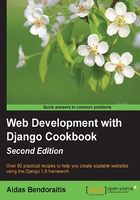
What this book covers
Chapter 1, Getting Started with Django 1.8, guides you through the basic configuration that is necessary to start any Django project. It will cover topics such as the virtual environment, version control, and project settings.
Chapter 2, Database Structure, teaches how to write reusable pieces of code to use in your models. When you create a new app, the first thing to do is to define your models. Also, you will be asked how to manage the database schema changes using Django migrations.
Chapter 3, Forms and Views, shows you some patterns used to create the views and forms for your data.
Chapter 4, Templates and JavaScript, covers practical examples of using templates and JavaScript together. We will bring together templates and JavaScript as information is always presented to the user by rendered templates and in modern website, JavaScript is a must for a rich user experience.
Chapter 5, Custom Template Filters and Tags, explains how to create and use your own template filters and tags. As you will see, the default Django template system can be extended to match template developers' needs.
Chapter 6, Model Administration, guides you through extending the default administration with your own functionality as the Django framework comes with a handy pre-built model administration.
Chapter 7, Django CMS, deals with the best practices of using Django CMS, which is the most popular open source content management system made with Django, and adapting it to your project's requirements.
Chapter 8, Hierarchical Structures, shows that whenever you need to create a tree-like structure in Django, the django-mptt module comes in handy. This chapter shows you how to use it and set administration for hierarchical structures.
Chapter 9, Data Import and Export, demonstrates how to transfer data from and to different formats, as well as retrieve it from and provide it to different sources. This chapter deals with the management commands for data import and also APIs for data export.
Chapter 10, Bells and Whistles, shows some additional snippets and tricks useful in everyday web development and debugging.
Chapter 11, Testing and Deployment, teaches how to test your project and deploy it on the remote server.